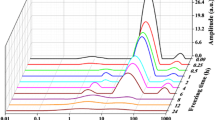Abstract
Amide proton transfer (APT) imaging is a new molecular magnetic resonance imaging (MRI) technique that gives contrast at the cellular protein level. To better understand the origin of the APT signal in tissue, fresh and cooked hen eggs (n = 4) were imaged at 4.7 T. The APT effect was quantified using the asymmetry in the magnetization transfer ratio (MTRasym) at the composite amide proton resonance frequency (3.5 ppm from the water resonance). The measured APT signals were significantly higher in the fresh egg white (20.1 ± 0.9%) than in the fresh egg yolk (−1.4 ± 1.1%; P < 0.001), and in the cooked egg white (2.8 ± 0.7%; P < 0.001), all of which have similar absolute protein contents. The data support the notion that the APT effect observed in vivo is associated with mobile proteins in tissue, such as those in the cytoplasm.


Similar content being viewed by others
References
K.M. Ward, A.H. Aletras, R.S. Balaban, J. Magn. Reson. 143, 79–87 (2000)
J. Zhou, P.C. van Zijl, Progr. NMR Spectr. 48, 109–136 (2006)
I. Hancu, W.T. Dixon, M. Woods, E. Vinogradov, A.D. Sherry, R.E. Lenkinski, Acta Radiol. 51, 910–923 (2010)
N. Goffeney, J.W.M. Bulte, J. Duyn, L.H. Bryant, P.C.M. van Zijl, J. Am. Chem. Soc. 123, 8628–8629 (2001)
S. Zhang, P. Winter, K. Wu, A.D. Sherry, J. Am. Chem. Soc. 123(7), 1517–1578 (2001)
S. Aime, A. Barge, D. Delli Castelli, F. Fedeli, A. Mortillaro, F.U. Nielsen, E. Terreno, Magn. Reson. Med. 47, 639–648 (2002)
J. Zhou, J. Payen, D.A. Wilson, R.J. Traystman, P.C.M. van Zijl, Nature Med. 9, 1085–1090 (2003)
K. Wuthrich, NMR of proteins and nucleic acids (John Wiley & Sons, New York, 1986)
P.Z. Sun, J. Zhou, W. Sun, J. Huang, P.C.M. van Zijl, J. Cereb. Blood Flow Metab. 27, 1129–1136 (2007)
K.T. Jokivarsi, H.I. Grohn, O.H. Grohn, R.A. Kauppinen, Magn. Reson. Med. 57, 647–653 (2007)
J. Zhou, B. Lal, D.A. Wilson, J. Laterra, P.C.M. van Zijl, Magn. Reson. Med. 50, 1120–1126 (2003)
A. Salhotra, B. Lal, J. Laterra, P.Z. Sun, P.C.M. van Zijl, J. Zhou, NMR Biomed. 21, 489–497 (2008)
J. Zhou, J.O. Blakeley, J. Hua, M. Kim, J. Laterra, M.G. Pomper, P.C.M. van Zijl, Magn. Reson. Med. 60, 842–849 (2008)
Z. Wen, S. Hu, F. Huang, X. Wang, L. Guo, X. Quan, S. Wang, J. Zhou, NeuroImage 51, 616–622 (2010)
J. Zhou, E. Tryggestad, Z. Wen, B. Lal, T. Zhou, R. Grossman, S. Wang, K. Yan, D.-X. Fu, E. Ford, B. Tyler, J. Blakeley, J. Laterra, P.C.M. van Zijl, Nature Med. 17, 130–134 (2011)
R. Jayasundar, S. Ayyar, P. Raghunathan, Magn. Reson. Imag. 15, 709–717 (1997)
S.J. Graham, G.J. Stanisz, A. Kecojevic, M.J. Bronskill, R.M. Henkelman, Magn. Reson. Med. 42, 1061–1071 (1999)
R.M. Henkelman, G.J. Stanisz, S.J. Graham, NMR Biomed. 14, 57–64 (2001)
J. Hua, C.K. Jones, J. Blakeley, S.A. Smith, P.C.M. van Zijl, J. Zhou, Magn. Reson. Med. 58, 786–793 (2007)
W. Ling, R.R. Regatte, G. Navon, A. Jerschow, Proc. Natl. Acad. Sci. USA 105, 2266–2270 (2008)
T. Kaewmanee, S. Benjakul, W. Visessanguan, Food Chem. 112, 560–569 (2009)
M.B. Smith, J.F. Back, Nature 193, 878–879 (1962)
Y. Mine, T. Noutomi, N. Haga, J. Agric. Food Chem. 38, 2122–2125 (1990)
C. Guerin-Dubiard, M. Pasco, D. Molle, C. Desert, T. Croguennec, F. Nau, J. Agric. Food Chem. 54, 3901–3910 (2006)
D.A. Omana, Y. Liang, N.N.V. Kav, J. Wu, Proteomics 11, 144–153 (2011)
Acknowledgments
We thank Dr. Peter van Zijl for helpful comments and Ms. Mary McAllister for editorial assistance. This work was supported in part by grants from NIH (EB009112, EB009731), and the Dana Foundation.
Author information
Authors and Affiliations
Corresponding author
Appendix
Appendix
1.1 Proteomic Analyses of the Fresh and Cooked Egg Whites
Protein extraction was performed using the PlusOne Sample Grinding Kit (GE Healthcare) according to the manufacture’s recommended protocol. Fresh and cooked egg white (~200 mg) were lysed with 1 mL lysis buffer (8 M urea, 2 M thiourea, 4% CHAPS, 1% DTT) separately. After centrifuging for 10 min at a maximum speed, clear supernatant was collected carefully. Protein labeling was performed for fluorescence two-dimensional (2-D) differential in-gel expression (DIGE) technology (GE Healthcare) according to the manufacturer’s recommended protocol. Each protein sample (50 μl) was labeled with a different fluorophore. The labeling mixture was subjected to 2D gel electrophoresis following protocols for pH 4–7. CyDye-labeled proteins were visualized using a Typhoon 9410 imager (GE Healthcare) and the images were shown in the black-white.
As reported previously [24, 25], several high-concentration proteins, such as ovalbumin, ovalbumin X, ovalbumin Y, ovotransferrin, ovoglycoprotein, ovoinhibitor, TENP, clusterin, and Hep21 protein, can be clearly observed in both fresh and cooked egg whites (Fig. 3). Of these, ovalbumin (45 kDa) is the most abundant protein that constitutes 54% of the total egg white proteins. Most proteins, including ovalbumin, didn’t show large changes after the thermal denaturation. However, the concentrations of ovotransferrin and ovoglycoprotein were decreased due to their heat-sensitive properties.
2D-DIGE images of the egg-white proteins from the fresh (left) and cooked (right) hen eggs. Nine large spots (ovalbumin, ovalbumin X, ovalbumin Y, ovotransferrin, ovoglycoprotein, ovoinhibitor, TENP, clusterin, Hep21 protein) are clearly visual in both gel images. The contents of most of these proteins were comparable in the two images, except two heat-sensitive proteins (ovotransferrin, ovoglycoprotein), whose concentrations reduced in the cooked case
Rights and permissions
About this article
Cite this article
Zhou, J., Yan, K. & Zhu, H. A Simple Model for Understanding the Origin of the Amide Proton Transfer MRI Signal in Tissue. Appl Magn Reson 42, 393–402 (2012). https://doi.org/10.1007/s00723-011-0306-5
Received:
Published:
Issue Date:
DOI: https://doi.org/10.1007/s00723-011-0306-5





